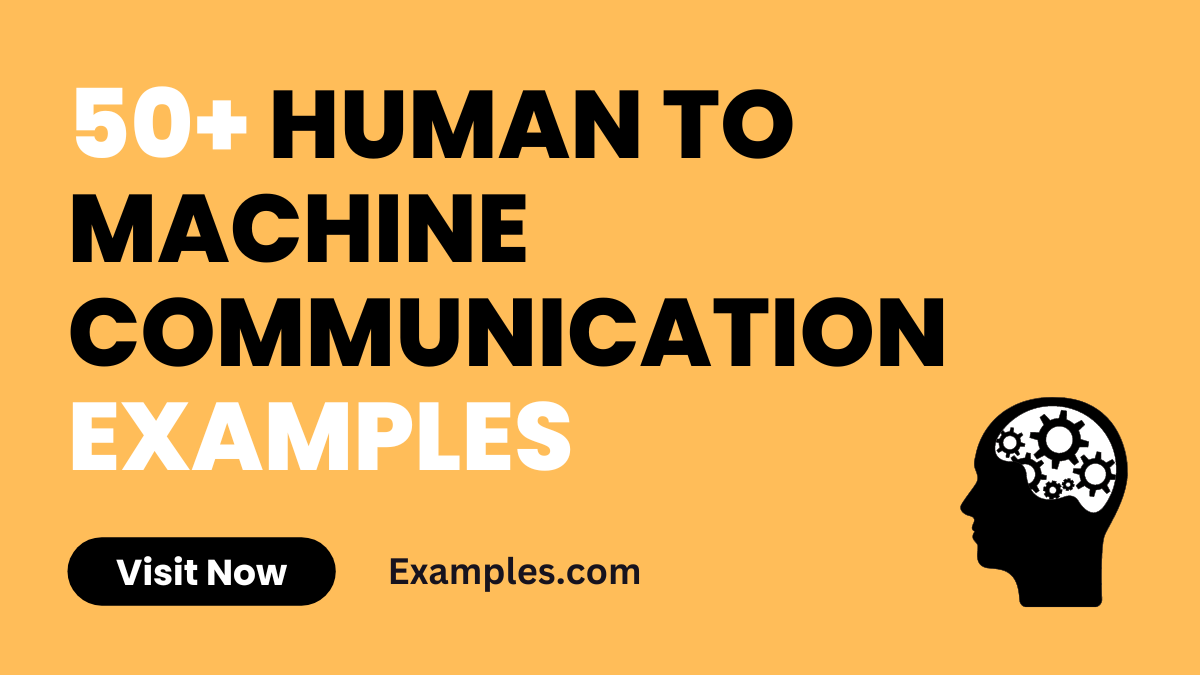49+ Human to Machine Communication Examples
In our comprehensive guide on Human to Machine Communication, we delve into the fascinating world where technology and human interaction converge. This guide offers a rich array of communication examples, showcasing how we communicate with devices in our everyday lives. From voice-activated assistants to gesture-controlled systems, we explore various forms of digital dialogue, providing insightful examples and practical tips. Embrace the future of communication as we unravel the complexities and ease of human-machine interactions.
What is Human-Machine Communication? – Definition
Human-Machine Communication (HMC) is the interaction between people and technology. It involves using various devices, from simple tools to complex computer systems, that understand and respond to human input. This type of communication can be as straightforward as pressing a button on a remote to as advanced as giving voice commands to an AI assistant. The essence of HMC lies in the effective exchange of information, ensuring that machines interpret and act on human instructions accurately. It’s a rapidly evolving field, incorporating elements of technical communication, digital communication, and communication technology.
What is the Best Example of Human to Machine Communication?
The quintessential example of Human to Machine Communication is the use of voice-activated virtual assistants, such as Amazon’s Alexa or Google Assistant. These assistants embody advanced HMC through their ability to understand and process human speech. When a user gives a command, like “Alexa, what’s the weather today?” or “Hey Google, play some music,” the assistant recognizes the voice, deciphers the words, and performs the task or provides the requested information. This interaction showcases verbal communication examples, where technology comprehends and responds to human speech, making it an excellent illustration of practical and sophisticated HMC. These assistants are not just standalone examples but part of a larger ecosystem of integrated marketing communications and smart technology, representing the future of interpersonal communication examples in the digital age.
50 Human to Machine Communication Examples
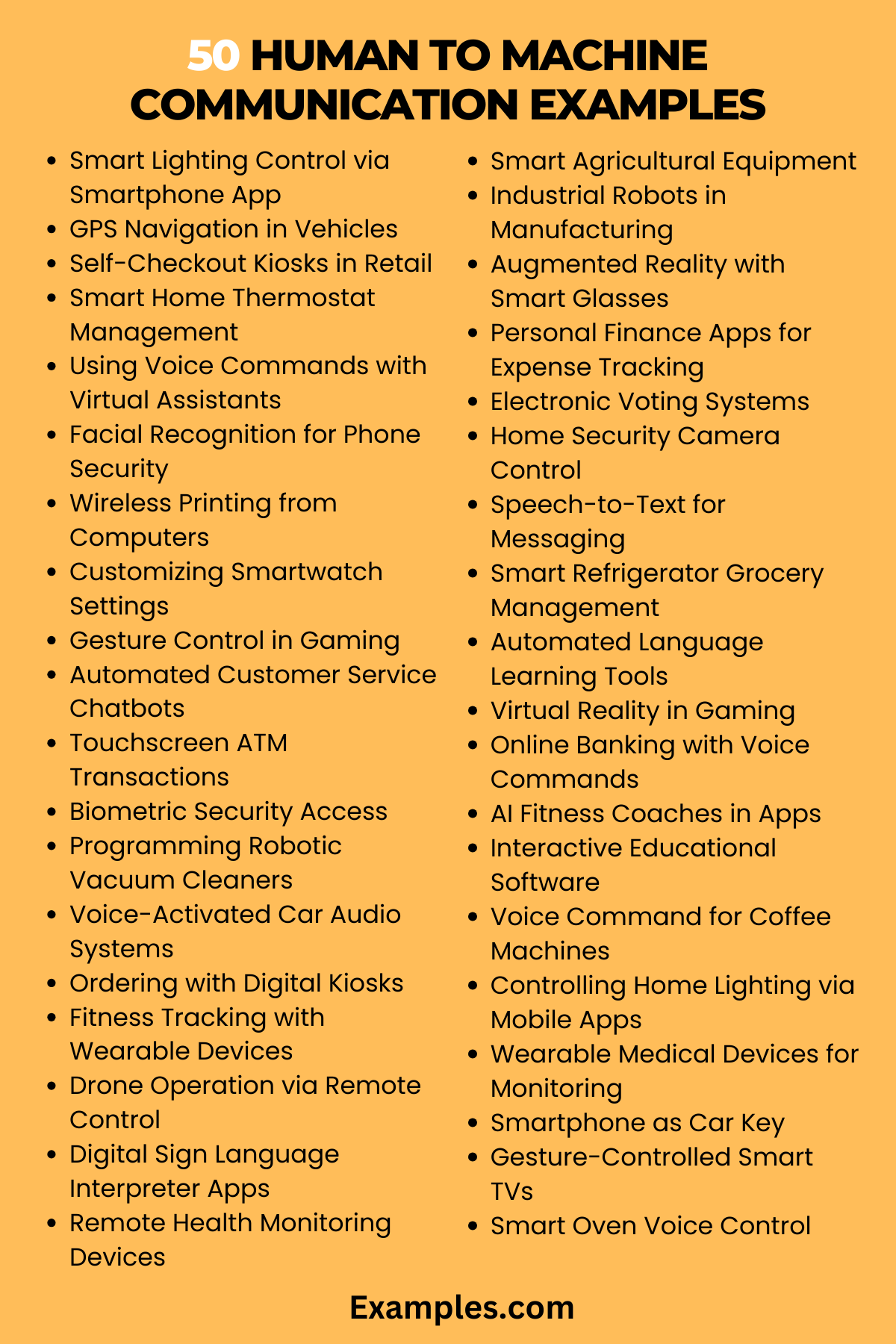
In this section, we present 50 examples of Human to Machine Communication (HMC), each accompanied by a brief explanation and sample communication sentences. These examples span a wide range of applications, from everyday gadgets to sophisticated systems, illustrating the versatility and advancement of HMC in our daily lives. By exploring these diverse scenarios, we gain insights into the ever-evolving landscape of digital communication, verbal communication examples, and communication technology examples, enhancing our understanding of how we interact with machines in various settings.
- Turning on a smart light via a smartphone app: Use an app to control the lighting in your home. “Turn on the living room lights.”
- Using GPS navigation in a car: Set destinations and receive directions. “Navigate to the nearest coffee shop.”
- Self-checkout kiosk at a store: Scan items and complete transactions yourself. “Scan item barcode; select payment method.”
- Smart home thermostat control: Adjust home temperature remotely. “Set thermostat to 72 degrees.”
- Voice commands to a virtual assistant: Ask questions or command tasks. “What’s my schedule for today?”
- Facial recognition for phone security: Unlock your phone using facial features. “Align face to the camera for scanning.”
- Wireless printing from a computer: Send documents to print remotely. “Print the attached document in color.”
- Adjusting a smartwatch: Customize settings and track activities. “Set alarm for 7 AM tomorrow.”
- Gesture control in gaming: Use body movements to control gameplay. “Swipe left to move the character.”
- Automated customer service chatbots: Interact for assistance or information. “I need help with my account.”
- Touchscreen ATM transactions: Conduct banking operations by touching the screen. “Select withdrawal and enter the amount.”
- Biometric security access: Use fingerprints or retina scans for access. “Place your finger on the scanner.”
- Programming a robotic vacuum cleaner: Set cleaning schedules and paths. “Clean the living room at 5 PM daily.”
- Voice-activated car audio systems: Control music or calls with voice. “Play the Beatles playlist.”
- Ordering via digital kiosks: Choose and pay for your order on-screen. “I’ll have a cheeseburger and fries.”
- Fitness tracking with wearable devices: Monitor health stats and activities. “Show my step count for today.”
- Drone operation via remote control: Navigate and control a drone. “Fly to the marked location.”
- Digital sign language interpreter apps: Convert sign language into text or speech. “Translate my signs into spoken English.”
- Remote health monitoring devices: Transmit health data to medical professionals. “Send my heart rate data to my doctor.”
- Voice-activated translation devices: Translate spoken words into different languages. “Translate ‘hello’ into Spanish.”
- Smart agricultural equipment: Respond to weather and soil data. “Adjust irrigation based on soil moisture levels.”
- Industrial robots in manufacturing: Automate tasks on assembly lines. “Assemble parts for Model X.”
- Smart glasses for augmented reality: Experience enhanced visual information. “Display walking directions on the lens.”
- Personal finance apps for expense tracking: Manage your spending and budget. “Categorize this expense as ‘Groceries’.”
- Electronic voting systems: Cast votes using digital interfaces. “Select your candidate and confirm your vote.”
- Home security camera control: Monitor and manage security remotely. “Show me the front door camera feed.”
- Speech-to-text for messaging: Convert spoken words into text messages. “Text Mike, ‘I’m on my way.'”
- Smart refrigerator grocery management: Keep track of food inventory. “Add eggs to the shopping list.”
- Automated language learning tools: Practice and learn new languages. “Start my French pronunciation practice.”
- Virtual reality for gaming: Immerse in a 3D gaming environment. “Load the underwater exploration game.”
- Online banking with voice commands: Perform banking tasks by speaking. “Check my account balance.”
- AI fitness coaches in apps: Receive personalized workout guidance. “Create a workout plan for weight loss.”
- Interactive educational software: Engage in digital learning activities. “Start the algebra tutorial.”
- Voice command for coffee machines: Start brewing coffee with a command. “Brew a medium cup of coffee.”
- Controlling home lighting via mobile apps: Adjust brightness or color. “Set living room lights to blue.”
- Wearable medical devices for monitoring: Track health metrics for patients. “Alert me if heart rate exceeds 100 bpm.”
- Smartphone car unlock and start: Use phone as a car key. “Unlock the car and start the engine.”
- Gesture-controlled smart TVs: Navigate channels or apps with hand movements. “Swipe right to browse Netflix.”
- Smart oven voice control: Adjust cooking settings by speaking. “Set oven to 350 degrees for 30 minutes.”
- Automated pet feeders: Schedule feeding times for pets. “Feed the cat at 8 AM and 6 PM.”
- AI personal finance advisors: Get financial advice and analysis. “Analyze my spending for the past month.”
- Smart mirrors for fashion advice: Receive outfit suggestions and grooming tips. “Show me casual outfit options.”
- Automated garden irrigation systems: Water plants based on environmental data. “Water the garden every morning at 7 AM.”
- Voice-controlled music streaming: Ask to play songs or playlists. “Play my ‘Morning Chill’ playlist.”
- Programming smart alarm clocks: Set alarms via a phone app. “Set an alarm for weekdays at 6:30 AM.”
- Digital art with stylus input: Create art on digital platforms. “Draw a sunset scene with watercolors.”
- Voice command for smart home blinds: Open or close blinds with voice. “Close the blinds in the bedroom.”
- Fitness band sleep tracking: Monitor and analyze sleep patterns. “Show my sleep quality report.”
- AI shopping assistants online: Get recommendations for online shopping. “Suggest gift ideas for a 10-year-old.”
- Telehealth remote patient consultations: Conduct medical appointments virtually. “Schedule a video consultation for Tuesday.
Human to Machine Communication Sentences Examples
Discover the simplicity and innovation in Human to Machine Communication through these sentence examples. Each example demonstrates how concise and clear communication can effectively command and interact with various technologies. From smart home devices to advanced software, these sentences embody the essence of practical communication examples in the digital era.
- “Set the alarm for 7:30 AM tomorrow.” Use this command to program your smart alarm clock. It shows the ease of scheduling with technology.
- “Check my heart rate.” A simple command for wearable health monitors, showcasing seamless health tracking.
- “Show the latest stock market updates.” Direct your smart display to provide real-time financial information.
- “Record the TV show tonight at 9 PM.” Schedule your smart TV to record your favorite program effortlessly.
- “Find the closest electric vehicle charging station.” Efficiently navigate to nearby facilities using your car’s smart navigation system.
Human to Machine Speech Communication Examples
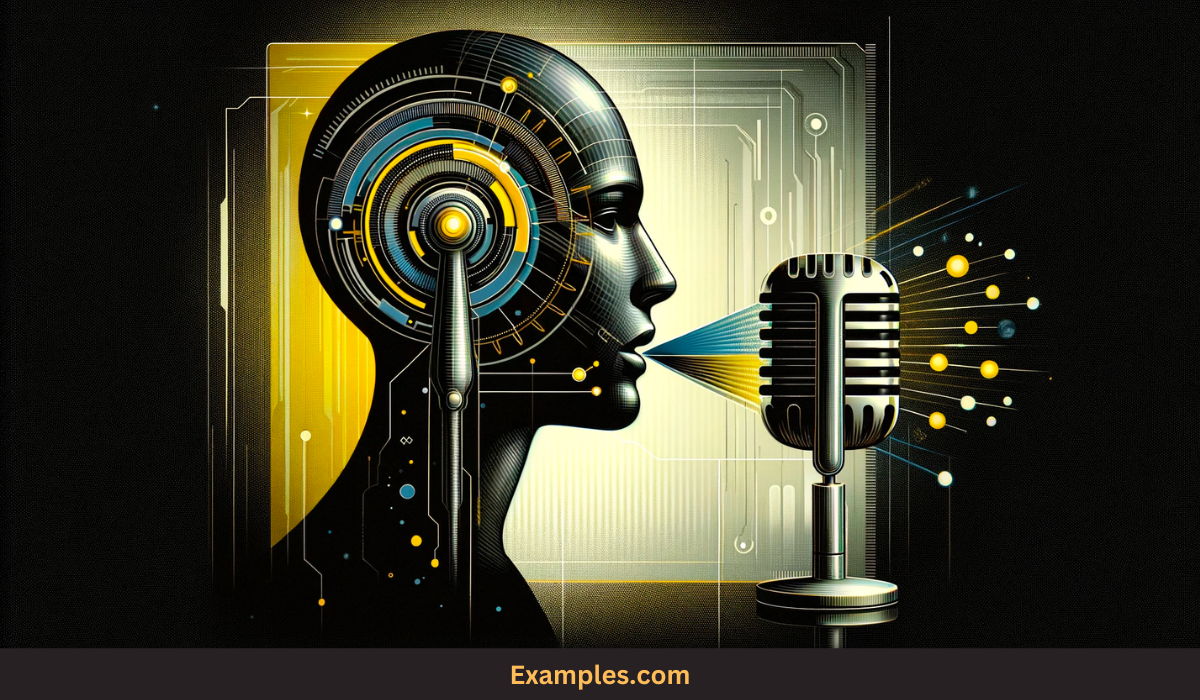
Explore the dynamic realm of Human to Machine Speech Communication with these examples. They highlight the natural and intuitive way we can interact with machines using our voice. These examples are perfect illustrations of verbal communication examples and digital communication in the context of modern technology.
- “Play the latest album by Coldplay.” Command your smart speaker to play music, showcasing the ease of voice-controlled entertainment.
- “Translate ‘Thank you’ into Japanese.” Utilize a translation device or app for instant language translation.
- “How long will it take to drive to downtown?” Ask your GPS for real-time traffic updates and route information.
- “Add carrots and milk to my shopping list.” Update your digital shopping list with voice commands for convenience.
- “What’s my schedule for tomorrow?” Inquire about your daily agenda from a virtual assistant for efficient planning.
Human to Machine Verbal Communication Examples
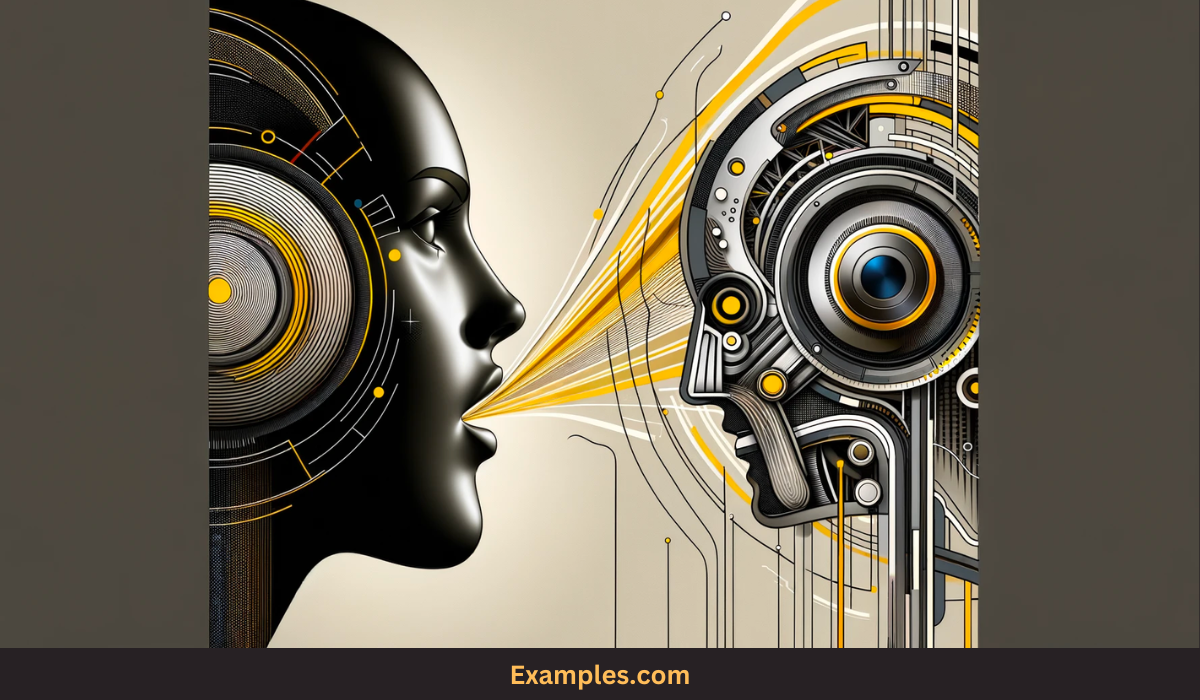
Human to Machine Verbal Communication is pivotal in today’s tech-driven world. These examples showcase how spoken words can effectively control and interact with various devices, emphasizing the importance of communication technology examples and effective communication in a digital setting.
- “Switch to night mode.” A command to your smart home system to adjust lighting and temperature for the evening.
- “Start the dishwasher.” Instruct your smart home appliance to begin its cycle with a simple verbal command.
- “Read my new emails.” Ask your digital assistant to verbally go through your latest emails.
- “Order a pizza from my favorite restaurant.” Use a voice-activated system to place an order, demonstrating convenient verbal commands.
- “Give me directions to the nearest coffee shop.” Utilize your car’s voice command system for navigation, making driving more convenient and safe.
The Role of Human-Machine Communication
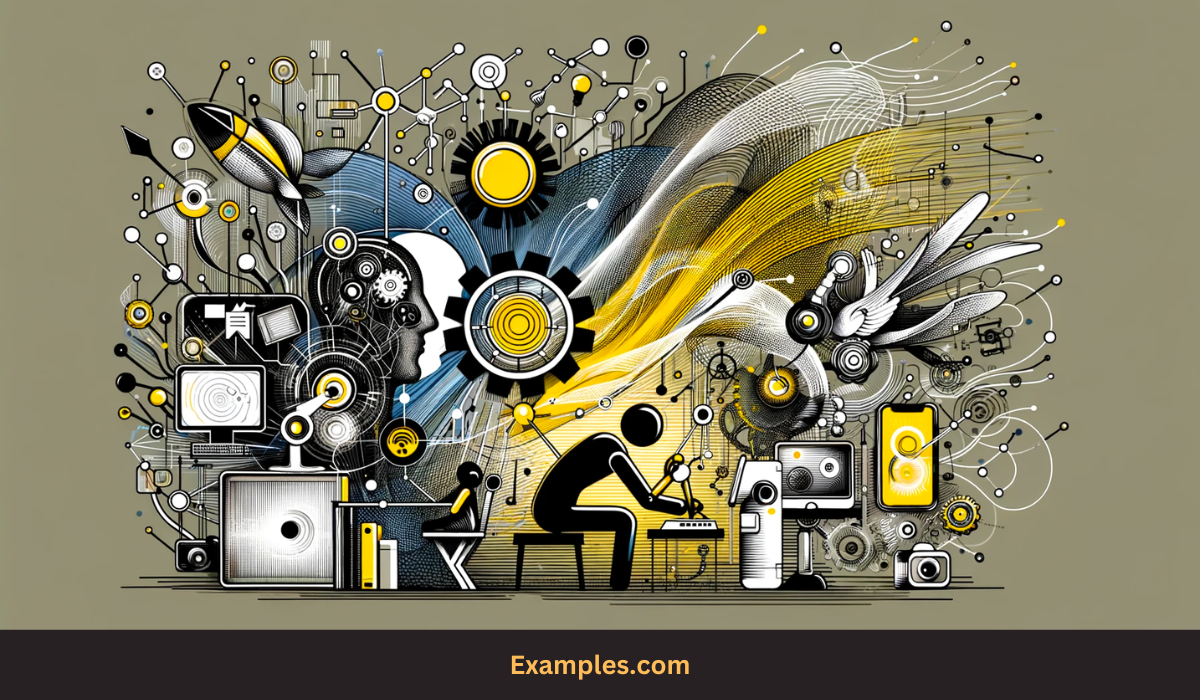
The role of Human-Machine Communication (HMC) is pivotal in the modern technological landscape. It serves as a bridge between human intuition and machine efficiency, enhancing our ability to interact with and control technology. HMC plays a crucial role in various sectors, including healthcare, where it allows for remote monitoring of patients, and in the automotive industry, where voice commands and autonomous driving are becoming more prevalent. In the realm of home automation, HMC facilitates convenient and personalized control over home environments. Its significance extends to effective communication in workplaces and communication in education, where interactive software and AI assistants are becoming indispensable tools. Overall, HMC is integral to making technology more accessible, intuitive, and user-friendly, thereby improving productivity and quality of life.
Challenges By Human-Machine Communication

While Human-Machine Communication has made significant strides, it also presents various challenges. One of the primary issues is the accuracy and reliability of machine interpretation of human input. Misunderstandings or errors in voice or gesture recognition can lead to frustrations or even hazardous situations, especially in critical applications like healthcare or transportation. Additionally, the privacy and security concerns surrounding the data collected through HMC devices like virtual assistants and wearable tech are significant. There’s also the challenge of designing interfaces that are intuitive and accessible to people of all ages and abilities, ensuring inclusive technology use. Addressing these challenges involves ongoing research and development in areas like natural language processing, communication technology examples, and digital communication security.
What is a Type of Machine to Human Communication
Machine to Human Communication (M2HC) is the process where machines convey information to humans. This communication type is integral in environments where machines provide feedback, alerts, or data for human interpretation. One common form is notifications on smartphones or computers, where the machine informs the user of updates or reminders. In industrial settings, machines communicate through control panels and alerts to inform operators of system statuses or safety warnings. In healthcare, wearable devices communicate vital health data to users and medical professionals. M2HC also includes the feedback received from AI in digital communication platforms, where algorithms suggest actions or provide analytics. This communication type is essential for effective human-machine collaboration, ensuring that humans can make informed decisions based on machine-provided data.
In conclusion, our guide on Human to Machine Communication provides a thorough understanding of how we interact with technology in our daily lives. From practical examples to addressing challenges and exploring machine-to-human communication types, this guide offers valuable insights and tips for navigating this dynamic field. Embrace these advancements for a more efficient and connected future.



